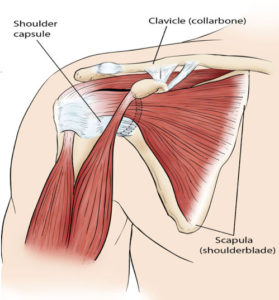03 Apr Frozen What? Frozen Shoulder
Frozen Shoulder –
A Common Shoulder Injury Condition
What exactly is Frozen Shoulder? Frozen Shoulder or Adhesive Capsulitis is inflammation and  scarring of the capsule surrounding the shoulder joint. The shoulder, itself, is a ball-and-socket joint. The round head of the upper arm bone (humerus) fits into this socket made up of the clavicle and the scapula. The shoulder joint is surrounded by connective tissue to form a capsule.
scarring of the capsule surrounding the shoulder joint. The shoulder, itself, is a ball-and-socket joint. The round head of the upper arm bone (humerus) fits into this socket made up of the clavicle and the scapula. The shoulder joint is surrounded by connective tissue to form a capsule.
Frozen Shoulder Causes
Frozen Shoulder is thought to happen when scar tissue forms in the joint capsule in the shoulder. This causes the shoulder joint’s capsule to thicken and tighten, leaving less room for movement. In doing so, shoulder movement may become stiff and painful.
The exact cause is not fully understood, and it cannot always be identified. However, most people experiencing Frozen Shoulder, shoulder stiffness and joint pain, have likely experienced immobility as a result of a recent injury such as a broken arm, and the inactivity of the arm following that injury. At times, it may develop with no known cause.
Frozen Shoulder Symptoms
The primary symptoms of Frozen Shoulder is pain and loss of movement in the shoulder joint. Lifting, reaching, and daily activities using the shoulder, such as putting on a shirt, may be difficult. Signs and symptoms develop gradually, and usually resolve on their own.
Common Symptoms Include:
- Pain at night
- Noticeable muscle wastage
- Very painful movements of the shoulder
- Guarding/hiking of the shoulder during movement
- Pain in the shoulder, which could be sharp or dull, but generally feels quite deep
Symptoms of Frozen Shoulder is thought to occur over three stages:
Stage 1: Pain. During the initial, early stage pain is the most prevalent symptom.
Stage 2: Frozen. Once pain starts to subside, stiffness begins to set in causing the shoulder to feel suck and frozen-like.
Stage 3:Thawing. The final stage occurs when pain has decreased, and shoulder motion begins to improve.
Frozen Shoulder Diagnosis
It is essential to have a doctor diagnose you for Frozen Shoulder because other shoulder problems, such as a torn shoulder muscle, are treated very differently. The process of diagnosing Frozen Shoulder are very simple and non-invasive. Your doctor will simply move your arm in various directions, taking note of any limitations in shoulder movement. An x-ray may be used in addition to your doctor’s observation of specific shoulder movement activity, which is then used to measure the range of motion with activities such as touching your opposite shoulder with your hand. Your doctor will suggest the most suitable treatment option depending on the severity of signs and symptoms.
Frozen Shoulder Treatment
The primary focus of treatment is to alleviate shoulder joint pain, preserve mobility, and increase flexibility in the shoulder. In time, and with treatment, it is believed that most all (90%) of those suffering with from Frozen Shoulder, experience relief.
Non-surgical treatment can include:
- Hand therapy to help with motion and pain,
- Medication to reduce inflammation and pain, or
- Cortisone injection.
Hand therapy by a Certified Hand Therapist, which may include:
- Exercises that will help restore motion, including stretching or range of motion exercises for the shoulder,
- Modalities such as heat may also be used to help loosen the shoulder before stretching, and Ice to reduce inflammation as well as a Transcutaneous Electrical Nerve Stimulation (TENS), which works by numbing the nerve endings in the spinal cord that control pain, and/or
- Nerve blocks, if stiffness in your shoulder makes exercise difficult, to limit pain and allow for more aggressive therapy.
Surgical treatment is also an option, but generally as a last resort if pain and motion do not improve. Whether your Frozen Shoulder treatment involves surgery or not, rehabilitation plays a vital role in getting you back to your regular daily activities.
If left untreated, the significance of shoulder joint pain and stiffness can last several years, and have several serious risk factors, including:
- Stroke
- Diabetes
- Parkinson’s disease
- Cardiovascular disease
- Women over 40 years of age
- Hypothyroidism, or under-active thyroid
- Hyperthyroidism, or over-active thyroid
No matter the treatment program, you, along with your physician and hand therapist, will work together as a team to achieve the best possible outcomes. A complete recovery timeline for Frozen Shoulder can range from 12 to 28 months. Although it is a slow process, your commitment to hand therapy is a key factor to a quick recovery and return to all the activities you enjoy.
About the Author:
Kathy Baker, OT, CHT
Kathy graduated from the University at Buffalo in 1992 with a Master’s Degree in Occupational Therapy. She continued her education at Texas Woman’s University where she became a Certified Hand Therapist.

